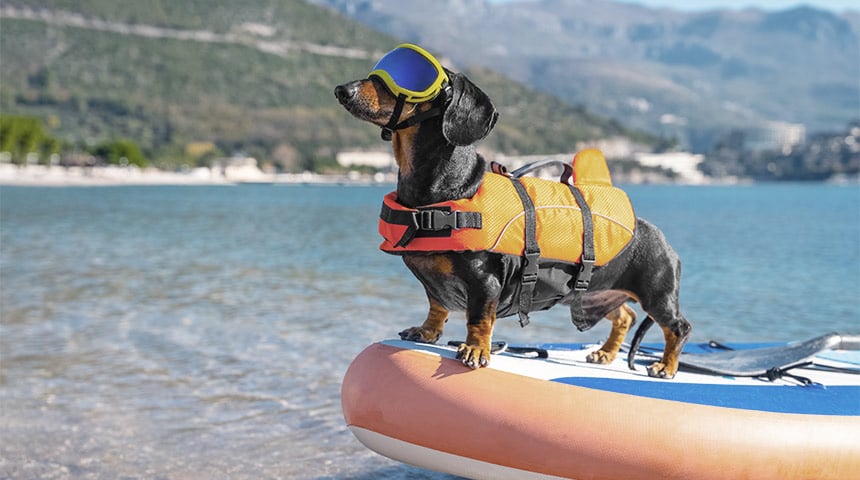Going on vacation and planning to go boating with your cat or dog? We have some tips to help you spend quality time with the whole family.
Whether your pet is a good swimmer or not, because in fact there are some dogs and cats that cannot swim, make sure to have the right life jacket for them. To choose the right life jacket, try it on your pet to ensure a perfect fit. Ask our team for assistance as we have a few models available for your pets. Make sure your pet wears the vest in their regular environment before going on the water, so they get used to wearing it. Flotation jackets for smaller animals usually come with a handle that allows you to get them out of the water if necessary. For larger animals, vests can be used as a flotation buoy if they become too tired to swim (as with children for that matter). Before your boating season starts, feel free to contact us for advice.
Before you leave, find a veterinary center that could help you in case of an emergency situation in the region where you are travelling to. In the province of Quebec, the OMVQ (Ordre des Médecins Vétérinaires du Québec) website will help you find one. In addition, make sure your pet will be accepted wherever you go (some places do not accept pets); and don’t forget to leashes and harnesses, along with any medication they take on a regular basis.
To get your small pets on a boat, you can put them in a cage or carrier and for large dogs, specially designed ramps that attach to the back of the boat are available. Once on board, make sure your pet does not suffer from seasickness; if he does, give him some time to acclimate to his environment. You will find products on the market to help reduce symptoms and stress associated with motion sickness. Also, make sure that your pet does not suffer from heat or heat stroke; to do so, make sure to keep your pet well hydrated without giving him too much iced water, and see that they do not stay in the sun all day. You will find in store several cooling mattresses that will help your companions stay cool; ask our team for advice, they will guide you in selecting them. In addition to cooling mattresses, there are some chew toys that can be frozen to help your animals cool off and have fun at the same time, all without causing frostbite.
When boating with your pet in very warm or very cold weather, a good habit to keep is to periodically check their paws to make sure they are not too hot in the summer or cold if you sail in low temperatures.
You should always keep enough food in a sealed watertight container as well as large quantities of drinking water for your companions, as they could need to drink more frequently than at home because of the heat or bad weather. In addition, the food and water bowls should not be installed in the tip of the boat (often a berth in the bow) because that is where they will feel the movement of the waves the most, and this can make mealtime quite unpleasant for your furry friends.
Once your cat or dog is well fed and hydrated, he will certainly need to relieve himself. For cats and small dogs, a litter is recommended; and again not located in the tip of the boat. For large dogs several strategies are available to you. Many pet owners make stops on land to let their pets stretch out their legs and relieve themselves at the same time; remember to bring a sealable bag to throw away feces in appropriate receptacles. Another approach, if pit stops on land are not an option, you can purchase a small square of synthetic turf used specifically for this purpose; but remember to bring the sealed bags and a brush to rinse off the turf before putting it away. Whatever solution you choose, it is important to allow time for your pet to get used to this new routine.





